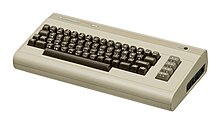1982年电子游戏界
事件
- 12月27日 - 游戏电视节目Starcade在美国TBS台开播。
- 杂志《电子游戏》举办了第三届街机游戏奖,授奖对象为1980-1981年发行的游戏。《吃豆人》(南梦宫吃豆人基板)赢得最佳街机奖,《爆破彗星》(雅达利2600)赢得最佳游戏机游戏奖,《星际掠夺者》(雅达利400/800)赢得最佳电脑游戏奖。
商业
- 8月-原营团社系统改名为艾尼克斯,进入电脑游戏发行业。
- Ultimate Play the Game(后Rare)建立。
- 艺电、Licasfilm Games、Compile、MicroProse、System 3和Artech Studios建立。
- 美国街机市场价值43亿美元[1],家用游戏市场价值38亿美元[2]。
- 日本家用游戏市场约3000亿日圆[3]。
知名产品
游戏
- 街机
- 1月-世嘉发行《Zaxxon》,一款开创等角投影和斜向卷轴的游戏。
- 1月13日-Midway发行了《吃豆人小姐》;这是《吃豆人》的续作,但未经南梦宫的授权。同年晚些时候,它们又未经授权发行了《吃豆人婴儿》和《吃豆人+》,其中前者为弹珠台和电子游戏的结合。
- 4月19日-南梦宫发行了《打空气》。
- 8月-任天堂发行了宫本茂的《大金刚Jr.》。
- 9月24日-南梦宫发行了《顶尖车手》,这是最早采用立体声和四声道的游戏之一。游戏采用伪三位、后视视角画面, 成为当时最流行的竞速游戏。
- 10月-南梦宫发行《超级吃豆人》,这是第三款(也是第二款官方)吃豆人游戏。
- 11月-科乐美发行《时间巡游者》,游戏采用时间旅行主题和非线性游戏风格,卷轴各个方向可无限延伸,即玩家的飞行器可以自由的开阔空间中飞行[4]。
- 12月-南梦宫发行《铁板阵》。
- 12月31日-Gottlieb发行《Q*bert》。
- Bally/Midway先于同名电影发行《電子世界爭霸戰》。
- 华纳通讯的雅达利发行《量子》。
- 威廉姆斯电子发行《鸵鸟骑士》和《机器人大战:2084》。
- 游戏机
- 3月-雅达利2600版《吃豆人》发行。据信这是引发1983年美国游戏业大萧条事件的原因之一。
- 9月-动视发行了史蒂夫·卡怀特的《Megamania》。
- 10月13日-Mystique在雅达利2600发行了成人遊戲《卡斯特的复仇》。
- 12月-雅达利发行了《E.T.外星人》,这可能是电子游戏史上最差的遊戲,也是引发1983年美国游戏业大萧条的另一大游戏。
- 动视发行了史蒂夫·卡怀特的雅达利2600游戏《Barnstorming》。
- 美泰兒在Intellivision平台发行了Don Daglow的《乌托邦》;这是最早的模拟游戏之一。
- Starpath发行了史蒂芬·兰德隆的《弑龙者》(雅达利2600唯一的RPG),以及《Escape From the Mindmaster》(也是雅达利2600游戏)。
- 帕克兄弟发行了雅达利2600与Intellivision游戏《星球大战:帝国反击战》,这是最早的星球大战游戏。
- 电脑
- 8月24日-《创世纪II:女巫的复仇》发行。
- 光荣在NEC的PC-8001家用电脑发行了最早的日式RPG《The Dragon and Princess》[5]。这是RPG采用战略回合制战斗的先例[6]。
- 光荣发行了可能是最早的日本成人游戏《Night Life》[7][a]。
- 波音佳丽发行了另一款早期日本RPG《间谍大作战》。游戏改编自剧集《虎膽妙算》,将传统的奇幻设定改为先带间谍设定[9][10]。
- Edu-Ware在Apple II、雅达利8位电脑和IBM PC发行了《囚犯2》。
- Sir-Tech发行了《巫术II:钻石骑士》,这是巫术系列的第二作。
- 雪乐山在Apple II发行了《Time Zone》[11]。这款图形冒险游戏由罗伯塔·威廉姆斯编剧、监督,采用6张双面软盘储存[12]。
硬件
- 街机
- 1月-世嘉推出了街机主板世嘉Zaxxon,引入了等距投影和斜向卷轴。
- 9月-南梦宫推出了南梦宫顶尖车手,采用了两枚Zilog Z8002处理器,这是最早使用16位微处理器的街机主板[13]。主板支持伪3D、精灵活动块,发色数达3840[14]。
- 游戏机

- 雅达利推出雅达利5200家用游戏机。
- Astrocade(原Astrovision)推出Astrocade。
- Coleco产业推出家用游戏机雅达利2600的仿制版,Coleco Gemini。
- 爱默生推出Arcadia 2001家用游戏机。
- Entex推出Adventure Vision家用游戏机。
- General Consumer Electronics推出Vectrex家用游戏机。
- Coleco推出ColecoVision家用游戏机。
- 电脑

- Commodore商业机器公司推出Commodore 64家用电脑,电脑后成为欧洲市场的领头羊,以及史上最畅销的电脑之一。
- NEC推出NEC PC-98,这是日本市场的领头者,亦是史上最畅销的电脑。电脑在日本外以“APC”名义发行。
- 夏普发行X1。
- 辛克莱研究推出ZX Spectrum家用电脑,这是英国当时最畅销的游戏电脑。
注釋
参考文献
- ^ Video Game Myth Busters - Did the "Crash" of 1983/84 Affect Arcades? (页面存档备份,存于互联网档案馆), The Golden Age Arcade Historian (December 27, 2013)
- ^ Everett M. Rogers & Judith K. Larsen, Silicon Valley fever: growth of high-technology culture, Basic Books: 263, 1984 [2015-04-18], ISBN 0-465-07821-4, (原始内容存档于2017-01-15),
Video game machines have an average weekly take of $109 per machine. The video arcade industry took in $8 billion in quarters in 1982, surpassing pop music (at $4 billion in sales per year) and Hollywood films ($3 billion). Those 32 billion arcade games played translate to 143 games for every man, woman, and child in America. A recent Atari survey showed that 86 percent of the US population from 13 to 20 has played some kind of video game and an estimated 8 million US homes have video games hooked up to the television set. Sales of home video games were $3.8 billion in 1982, approximately half that of video game arcades.
- ^ 存档副本 (PDF). [2015-04-18]. (原始内容存档 (PDF)于2020-10-24).
- ^ Konami Classics Series: Arcade Hits - NDS - Review. GameZone. April 9, 2007 [2011-04-08]. (原始内容存档于2013-01-27).
- ^ ランダム・アクセス・メモ. Oh! FM-7(日语:Oh!FM): 4. 4 August 2001 [19 September 2011]. (原始内容存档于2012-09-20). (Translation (页面存档备份,存于互联网档案馆))
- ^ Hardcore Gaming 101 - Blog: Dark Age of JRPGs (1): The Dragon & Princess (1982). [2015-04-18]. (原始内容存档于2014-11-07).
- ^ Jérémie Pelletier-Gagnon and Martin Picard. Beyond Rapelay: Self-regulation in the Japanese erotic video game industry. Matthew Wysocki and Evan W. Lauteria (编). Rated M for Mature: Sex and Sexuality in Video Games. Bloomsbury. 2015: 28–41 [2022-03-22]. ISBN 978-1628925777. (原始内容存档于2022-04-24).
- ^ 宮本直毅. ハドソンの『野球拳』. エロゲー文化研究概論 増補改訂版 第1版第1刷. 総合科学出版. 2017-05-15: 19. ISBN 978-4-88181-859-6.
- ^ Hardcore Gaming 101 - Blog: Dark Age of JRPGs (2): Some games we cannot play. [2015-04-18]. (原始内容存档于2014-11-07).
- ^ Oh!FM-7:スパイ大作戦(ポニカ). [2015-04-18]. (原始内容存档于2020-11-16).
- ^ Time Zone: An interview with Roberta Williams. Computer Gaming World. May–June 1982: 14–15.
- ^ Maher, Jimmy. Time Zone. The Digital Antiquarian. 2012-06-05 [10 July 2014]. (原始内容存档于2020-10-26).
- ^ 存档副本 (PDF). [2015-04-18]. (原始内容存档 (PDF)于2021-01-12).
- ^ 存档副本. [2014-11-06]. (原始内容存档于2014-10-06).
| ||||||||||||||||||||||||||||||||||||||||||||||||||||||||||||||||||||||||||||










